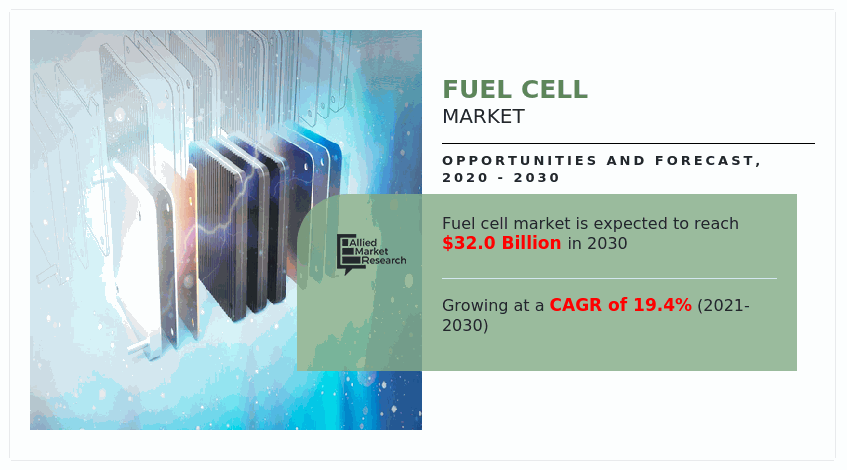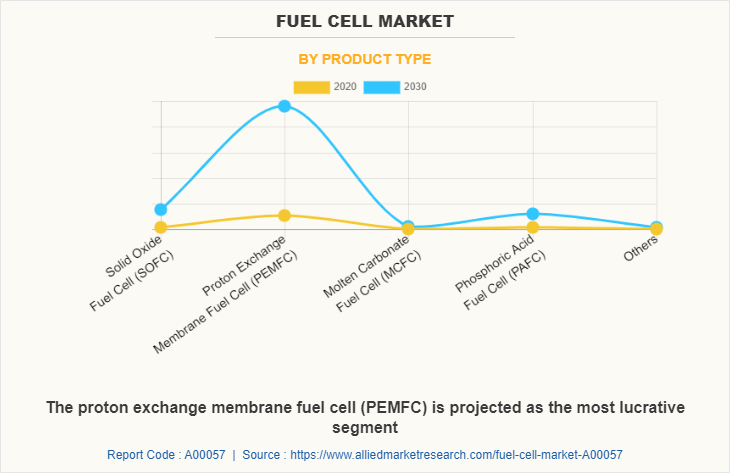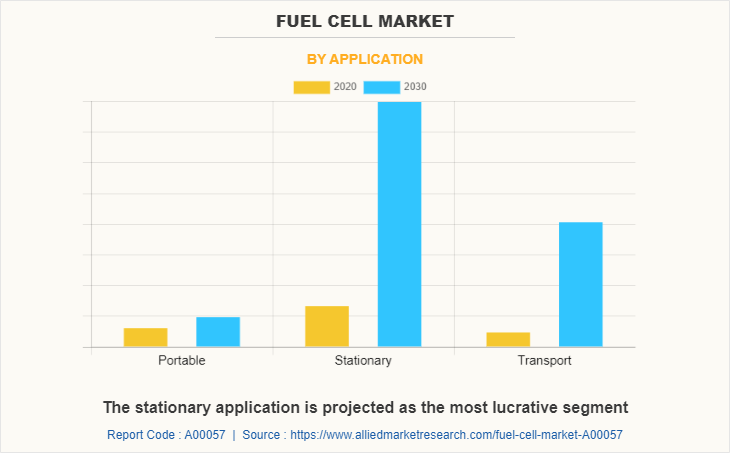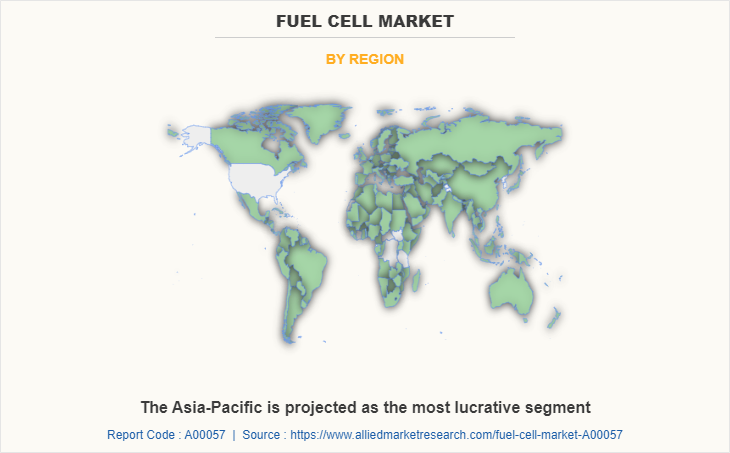Fuel Cell Market Size & Insights:
The global fuel cell market size was valued at USD 3.6 billion in 2020, and is projected to reach USD 32.0 billion by 2030, growing at a CAGR of 19.4% from 2021 to 2030. Rise in need for clean energy and increased use of fuel cells in the automotive and transportation sectors are key factors driving the market growth. With rise in focus on reduced emissions and sustainable alternatives from industries and governments, fuel cells offer a reliable, eco-friendly solution, particularly in electric vehicles and public transport, accelerating market expansion.
Introduction
A fuel cell is an electrochemical device that converts chemical energy from a fuel, typically hydrogen, directly into electrical energy through a reaction with oxygen. Unlike conventional power generation methods, fuel cells do not involve combustion, resulting in minimal emissions, usually limited to water and heat. They operate silently and efficiently, providing a clean and renewable energy source for various applications, including transportation, stationary power generation, and portable devices. Fuel cells consist of an anode, cathode, and electrolyte, where the electrochemical reactions occur, producing electricity continuously as long as fuel is supplied. Their high energy efficiency and environmental benefits make them promising alternatives for reducing reliance on fossil fuels.

Market Dynamics
Rise in adoption of fuel cells in automotive and transportation sectors is a key driver for the market growth. Fuel cell vehicles (FCVs) offer zero emissions, using hydrogen to produce electricity, making them a clean alternative to traditional internal combustion engines. Governments and manufacturers are increasingly investing in hydrogen-powered vehicles, particularly for buses, trucks, and trains, due to their high energy efficiency and longer range compared to battery-electric vehicles. According to Invest India, India's automotive industry was worth around $222 billion, while the EV market in India was valued at $2 billion by 2023 and $7.09 billion by 2025. Further, the automotive industry accounts for 8% of all national exports. This sector accounts for 40% of the total $31 billions of global research and development spending. Thus, the growing demand for sustainable transportation solutions, coupled with advancements in hydrogen refueling infrastructure, is accelerating the shift towards fuel cells in the automotive industry, driving market expansion.
The growing demand for clean energy solutions is a key driver of the fuel cell market growth. As industries and governments prioritize reducing carbon emissions and transitioning to sustainable energy sources, fuel cells offer an efficient, low-emission alternative to traditional fossil fuels. Fuel cells produce electricity with minimal environmental impact, emitting only water and heat as byproducts. This makes them attractive for use in transportation, power generation, and industrial applications. Increased awareness of climate change, alongside policies supporting green technologies, has accelerated the adoption of fuel cells, further propelling market expansion in various sectors.
High production costs significantly restrain the growth of the fuel cell market. Fuel cells require expensive materials like platinum for catalysts, which increases the overall manufacturing cost. Also, complex production processes and limited economies of scale further elevate expenses, making fuel cells less competitive as compared to conventional energy technologies. These high costs hinder widespread adoption, particularly in cost-sensitive industries such as transportation and power generation. Until production costs are reduced through innovations in materials, manufacturing efficiency, and scaling up production, the fuel cell market is set to struggle to achieve large-scale commercialization and price parity with traditional energy solutions.
Technological advancements in fuel cell efficiency present significant opportunities for the fuel cell market. Improvements in materials, catalysts, and designs have enhanced energy conversion rates, reducing fuel consumption while increasing power output. These innovations help lower costs, making fuel cells more competitive with traditional energy sources. Enhanced durability and longer lifespans also make fuel cells more attractive for large-scale applications like transportation, industrial use, and power generation. As efficiency continues to improve, fuel cells become a more viable solution for reducing carbon emissions and transitioning to cleaner, renewable energy systems, thus driving the market growth.
Market Segmentation
The fuel cell market is segmented into product type, application, and region. The study highlights various product types of fuel cells available in the market, such as Solid Oxide Fuel Cells (SOFC), Proton Exchange Membrane Fuel Cells (PEMFC), Molten Carbonate Fuel Cells (MCFC), Phosphoric, Acid Fuel Cells (PAFC), and others. On the basis of application, the market is segmented into portable, stationary, and transport. Region-wise, the market is analyzed across various regions such as North America, Europe, Asia-Pacific, and LAMEA.
By Type
By product type, the proton exchange membrane fuel cell (PEMFC) segment held the largest fuel cell market share in 2020, owing to rise in demand for clean power generation and dependence on fuel cell-based transport applications. In addition, PEMFC offers various advantages, such as low operational cost, improved reliability, less maintenance time, high operational efficiency, and others that are further projected to fuel the growth of the market in the coming years.

By Application
On the basis of application, the stationary segment dominated the global market in 2020, in terms of share, owing to rise in demand for fuel cells from backup power applications and distributed generation facilities. In addition, fuel cell is increasingly used in the combined heat & power applications, which in turn is further expected to drive the fuel cell market growth of this segment in the upcoming years.

By Region
Asia-Pacific garnered the highest share in the fuel cell market in 2020, in terms of revenue, and is anticipated to maintain its dominance during the forecast period. This is attributed to the presence of huge consumer base, rapid development of the hydrogen sector, fuel cell systems, and existence of key players in the region. Moreover, presence of the developing countries in Asia-Pacific, such as China, Japan, India, and South Korea increase the demand for fuel cells in transport applications, which in turn is anticipated to contribute toward the growth of the fuel cell market in Asia-Pacific.

Competitive Analysis
Key players operating in the global fuel cell market are Bloom Energy, Doosan Fuel Cell America, Inc., Ceres Power Holdings Plc, Plug Power, Inc., Fuel Cell Energy, Inc., Ballard Power Systems, SFC Energy AG, Nedstack Fuel Cell Technology B.V., Intelligent Energy, and Nuvera Fuel Cells, LLC. Other players operating in the fuel cell market are Kyocera, Solid Power, Altergy, Horizon Fuel Cell, and others.
These players are adopting numerous strategies, such as product launch, agreement, and partnership to stay competitive in the fuel cell market.
For instance, in November 2021, Ballard Power Systems collaborated with Caterpillar Inc. and Microsoft. This collaboration aimed at demonstrating megawatt-scale hydrogen fuel cell backup generator system for datacenters. Through this collaboration, Ballard is expected to provide an advanced, 1.5 MW ClearGenTM-II hydrogen fuel cell power generator.
The fuel cell market is analyzed in accordance with the impacts of the drivers, restraints, and opportunities. The period studied in this report is 2021–2030. The report includes the study of the fuel cell market with respect to the growth prospects and restraints based on the regional analysis. The study includes Porter’s five forces analysis of the fuel cell industry to determine the impact of suppliers, competitors, new entrants, substitutes, and buyers on the fuel cell market growth.
Key Benefits for Stakeholders
- This report provides a quantitative analysis of the market segments, current trends, estimations, and dynamics of the fuel cell market analysis from 2020 to 2030 to identify the prevailing fuel cell market opportunities.
- The market research is offered along with information related to key drivers, restraints, and opportunities.
- Porter's five forces analysis highlights the potency of buyers and suppliers to enable stakeholders make profit-oriented business decisions and strengthen their supplier-buyer network.
- In-depth analysis of the fuel cell market segmentation assists to determine the prevailing market opportunities.
- Major countries in each region are mapped according to their revenue contribution to the global market.
- Market player positioning facilitates benchmarking and provides a clear understanding of the present position of the market players.
- The report includes the analysis of the regional as well as global fuel cell market trends, key players, market segments, application areas, and market growth strategies.
Fuel Cell Market Report Highlights
| Aspects | Details |
| By Application |
|
| By Product Type |
|
| By Region |
|
| Key Market Players | BALLARD POWER SYSTEMS INC., Nuvera Fuel Cells, LLC, FUEL CELL ENERGY INC., Ceres Power Holdings Plc, Bloom Energy, SFC ENERGY, Nedstack Fuel Cell Technology B.V., Intelligent Energy, Doosan Fuel Cell America, Inc, PLUG POWER INC. |
Analyst Review
The huge potential in Asia-Pacific to set up hydrogen infrastructure & industries and surge in demand for fuel cells from stationary and transportation applications are expected to provide lucrative opportunities to leading fuel cell manufacturers. Rapid industrialization and growth of the renewable energy sector are the key factors attributed to the leading position of Asia-Pacific.
Increase in demand for portable devices, stringent government regulations aimed at reducing the increasing pollution levels, and enhanced efficiency of fuel cells are expected drive the growth of the fuel cell market during the forecast period. In addition, rise in awareness towards advantages associated with fuel, such as reduced greenhouse gas emissions, high reliability, flexibility installation & operation, and others is anticipated to fuel the growth of the fuel cell market during the forecast period. However, high cost is a major limitation for purchasing fuel cell systems. On the contrary, numerous players are stepping in the fuel cell market with innovative products and emerging technologies. For instance, new type of fuel cells is expected to increase the competition in the upcoming years.
Among the analyzed regions, Asia-Pacific is likely to account for the highest revenue in the market during the fuel cell market forecast period, followed by North America, Europe, and LAMEA.
Rise in demand for clean power generation for transport and power sector is expected to be the key trend in the global fuel cell market
Stationary is the leading application of fuel cell market
Asia-Pacific & Europe will provide more business opportunities for Fuel Cell Market in future
Agreement, product launch and investments are key growth strategies of key players in the fuel cell market
Bloom Energy, Doosan Fuel Cell America, Inc., Ceres Power Holdings Plc, Plug Power, Inc., Fuel Cell Energy, Inc., Ballard Power Systems, SFC Energy AG, Nedstack Fuel Cell Technology B.V., Intelligent Energy, and Nuvera Fuel Cells, LLC are the leading players active in the Fuel Cell Market
On the basis of product type, proton exchange membrane fuel cell will drive the fuel cell market growth during the forecast period. By application, transport application will drive the growth of the market in the coming years
Potential customers of fuel cell industry includes transportation, power, and others
Transport and stationary application will drive the adoption of fuel cell market during the forecast period
Loading Table Of Content...



